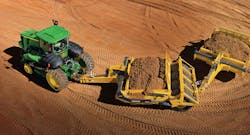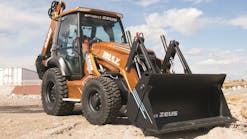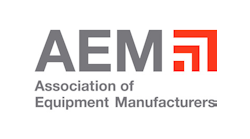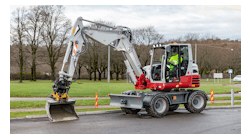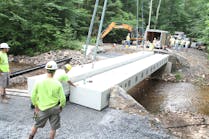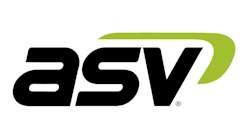Anything worth considering is worth reconsidering. Take the two most common methods of excavating for site preparation of residential tracts, industrial parks, and large commercial/shopping-mall areas. They are, of course, the hydraulic excavator used with articulated trucks or the bulldozer (pusher) and self-propelled scrapers. Each system is worthy of reconsideration in terms of which is most cost-effective. And much consideration has been given in recent years as to what system is better. Some site-preparation contractors have settled exclusively on articulated trucks while others use only scrapers. That has much to do with where the contractor is in the country and the prevalent ground conditions he works in. Most projects that require excavating rock in the form of large cobbles and larger, or competent rock that needs blasting, are best served by the use of an excavator with articulated trucks. Arguably this excavating/hauling system is preferred for excavating in heavy, wet, and slippery soils that have a tendency to restrict the efficiency of operating scrapers.As for light to heavy soils with relatively low moisture and no appreciable rock in the soil, the scraper is very effective, providing that the haul distance from point of excavation to the point of dumping is less than 2,000 ft.All of this mentioned about the two excavation systems are the sentiments of Jack Muschlitz, vice president of Muschlitz Excavating Inc. in Bath, PA. His opinion is that both systems are effective for his company’s applications, depending on the given project.Muschlitz is one of three family partners who founded the company in 1990. The other two partners are his father Ronald and brother Dave. Ronald manages the residential-site projects, and David acts as a job foreman. Jack supervises all of the commercial and industrial-site projects.Jack is a firm believer in both excavating systems and advances the argument that, for the area the company serves, there are excavating ground conditions that lend themselves to both articulated trucks and scrapers. He explains, “We have some projects where the cuts are not too deep and the ground to be excavated is practically rock-free. The cycle distances also are very short. Here, scrapers do very well. We also have sites where the haul distances are 2,000 ft. or more or the ground is too rocky or too wet for operating scrapers, so we use excavators and articulated trucks.”Here is a lineup of equipment the company currently uses for excavating and hauling on site-work projects. There are five Volvo A30C (30-ton-capacity) articulated trucks and six 20-yd.3-capacity Caterpillar 627E scrapers. Caterpillar D-8 bulldozers are used to push the scrapers. At present, Jack has three different makes of 100,000-lb. excavators demonstrated on a project for deciding which one to purchase. One of the excavators is a new Volvo model 460. Two reasons he is evaluating the Volvo excavator is because of the very attractive pricing and because the company owns one each of Samsung model 350 and 130 excavators, and Jack finds both to be quite satisfactory in performance. Noteworthy is that the Samsung product line was bought by Volvo, and now the excavators are sold under the Volvo label. Volvo has made many design improvements to excavators.The Volvo excavator is loading the five Volvo trucks at the Lehigh Valley International Airport. This project calls for making a deep cut between the end of a runway and an apron. The purpose of the cut is to bring to grade and increase the size of the apron. The excavated ground is used for backfilling a low area at the end of the runway for the purpose of lengthening it. Once completed and paved by others, the runway will accommodate the landing and taking off of larger jet aircraft.The use of articulated trucks currently proves more cost-effective than scrapers, according to Jack, because the cycle distances are 6,000-8,000 ft. Another reason is that there is too much loose rock in the soil for using scrapers. The production is averaging 5,000 yd.3 per 10-hour shift.The total quantity of ground to be excavated is 125,000 yd.3 Once the project is completed, the trucks will be moved to another project. The next project is a commercial site that calls for the excavation of 500,000 yd.3 of ground and limestone rock. Once the overburden has been stripped using the scrapers, the rock will be drilled and blasted, followed with a hydraulic excavator digging and loading the Volvo trucks.“This is one of those projects where both trucks and scrapers need to be used for excavating it at the least cost,” Jack notes. “We have our share of rock projects. In fact, I would say about half the projects have rock to be excavated.”Rent Them, Buy ThemSince at least half of the projects include rock excavation, the company owns two of the Volvo trucks, which were purchased last year. The other three are on rent, but that could change depending on future work for the company. Jack says he generally will not rent equipment more than six months at a time because it becomes no longer economical. Rather than continue further, he takes the option of purchasing.He would rather buy new trucks than used ones. By comparison, he prefers to buy used scrapers. The reasoning is that he finds he can justify the purchase of new trucks but not scrapers. The advantage to purchasing used scrapers is that they depreciate less because of the lower purchase price, and thus this lower depreciation figure is spread over the scraper’s total production, keeping the cost per yard excavated lower.Jack states there are three factors he considers when buying new equipment, such as the Volvo trucks: production performance, reliability, and–least important–purchase price. “I realize a lot of contractors make the price of equipment the most important factor when buying new equipment. I do not consider only the price for the simple reason that it is [more about] how well that machine performs and its reliability. If it produces higher and is more reliable than a lower-priced machine, I will more than likely opt for the higher-producing machine. It is the profitability of the equipment and not its first cost that I am interested in,” Jack emphasizes.It’s working for this company: using both excavation methods, that is. The company started only 10 years ago and has grown into a profitable $10 million company that employs 65 people. Business activities have been robust year-round, with the exception of occasional interruptions caused by winter weather.
